Obsidian comes in quite a few varieties and you’re bound to find them at your local rock and mineral show. The material is great for lapidary artists looking to cut and polish them because it’s very forgiving and produces nice-looking cabochons and carvings. If you haven’t considered adding Obsidian to your collection then I think you should look into some of the varieties below.
If you don’t know what Obsidian is then here is the short breakdown of how it grows and where it can be found. It’s an igneous rock that occurs as a natural glass formed by the rapid cooling of viscous lava from volcanoes. It is incredibly rich in silica, low in water, and has a chemical composition similar to Rhyolite.
Obsidian produces a glassy luster and is slightly harder than the glass of windows. While Obsidian is typically jet-black in color, the presence of Hematite or iron oxide has brown and red varieties, and the inclusions of tiny glass bubbles can create a beautiful golden sheen. Other types of Obsidian with dark bands or mottling in yellow, gray, or green are also known.
Different Types of Obsidian
The Glass Buttes are ancient volcanic hills that hold a stunning variety of gem-quality Obsidian, including red, mahogany, flame, jet black (Xaga), midnight lace, brown, pumpkin, rainbow, silver sheen, gold sheen, lizard skin, snowflake, green, and more.
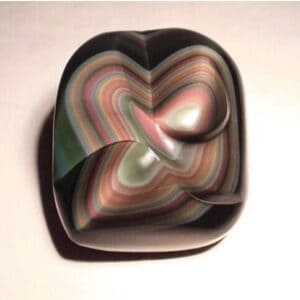
Rainbow Obsidian
Obsidian is a dense volcanic glass that usually contains a Rhyolite composition and is typically black but there are varieties that show a play of color. Rainbow Obsidian displays a multicolored iridescence caused by inclusions of magnetite nanoparticles, which results in an incredible rainbow-like pattern.
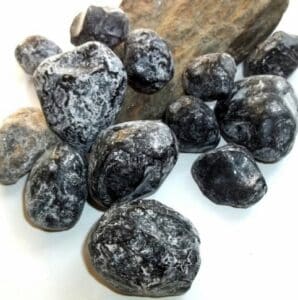
Obsidian Rock
Obsidian is often formed in Rhyolite lava flows where the lava cools so incredibly quickly that crystals don’t have time to grow. These igneous rocks form from melted rocks or magma. If it were an igneous rock that formed from magma underground and not from an eruption, it would be called an intrusive rock. A great example of regular Obsidian is an Apache tear. These balls of Obsidian have an interesting history and recommend you read my article dedicated to them.
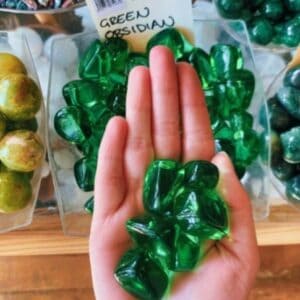
Green Obsidian
Green Obsidian is a beautiful green type of volcanic glass. While Obsidian is relatively rare, the green variety is even rarer but the buyer needs to beware of sellers claiming they have natural green Obsidian when in fact it is man-made glass.
Green Obsidian is found primarily in the western United States, in areas that experienced recent volcanic activity. While it’s technically a rock, Obsidian has a vitreous or glass-like texture that can be polished to an incredibly high shine and is often used in decorative items and jewelry. Green Obsidian gets its beautiful green color from the presence of iron oxide and is similar to the color of Emerald.
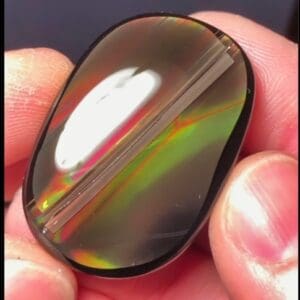
Fire Obsidian
Fire Obsidians are an incredibly rare variety of iridescent obsidians that are found in southeast Oregon. These gems are characterized by their vibrant color and patterns that are caused by the presence of thin layers of Magnetite within the glass. The colors of Fire Obsidian can vary greatly. However, they often include red, orange, yellow, blue, and green. The patterns of specimens can be concentric circles, bands, or other geometric shapes.
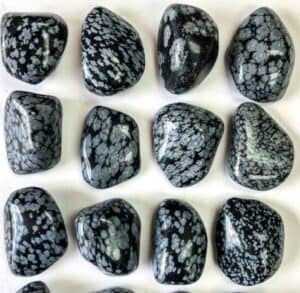
Snowflake Obsidian
Snowflake Obsidian is made up predominantly of silicon dioxide that comes in the form of a black stone with incredible white veins that run throughout it. The crystal growths are caused by different temperatures while the molten rocks are cooling off, which results in what appears to be snowflakes or patches of stars. This incredibly distinct quality makes this variety very popular among junior rockhounds.
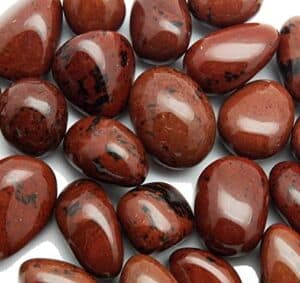
Mahogany Obsidian
Mahogany Obsidian is also known as Mountain Mahogany. This natural glass Obsidian contains iron inclusions that create mahogany-colored swirls and strips throughout the stones. Obsidian can be found anywhere that volcanic activity has occurred and some of the most notable sources today include South America, Mexico, Japan, Afghanistan, and different parts of the United States.
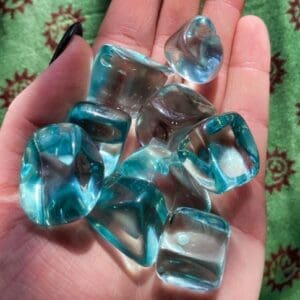
Blue Obsidian
Blue Obsidian specimens appear much different from the black variety. They are a beautiful pale blue color and display features in a transparent, translucent film that looks incredibly similar to glass. You need to be careful when buying Blue Obsidian because it is easily faked with man-made glass.
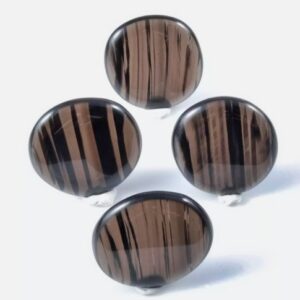
Midnight Lace Obsidian
Midnight Lace Obsidian is a relatively new stone that was recently discovered in the Caucasus Mountains of Russia, Georgia, Armenia, and Azerbaijan. It’s an incredible midnight black color with delicate lace-like patterns throughout the stone. These are pretty cool when you hold them up to the light because you can see the natural flows that occurred when it was forming. It’s almost like you get to see into the past, right when it was forming.
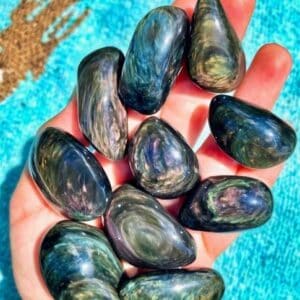
Velvet Peacock Obsidian
Velvet Obsidian is also known as Peacock and Seafoam Obsidian. These beautiful stones display stunning colors under bright lights but are somewhat mottled, allowing us to see into the glass specimens. When the stones are moved under the light, one gets a sense of movement in the stone as the light plays into and off of the lighter and darker areas of color. One big difference between this variety of Obsidian and others is that the stones exhibit color even when they’re not under bright lights. Still, the show is nowhere near as stunning as when they are viewed under light.
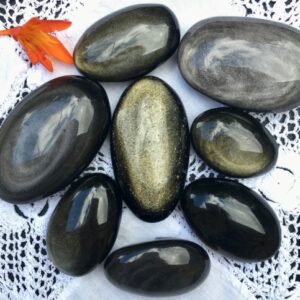
Sheen Obsidian
Sheen Obsidian reminds me of metal when you look at it under the light. These bright and shiny patches appear inside the stone resembling brushed stainless steel or brushed brass. These make for great cabochons, spheres, and carvings.
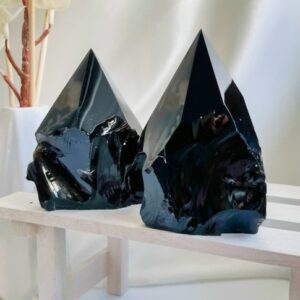
Xaga Obsidian
Xaga is another name for Black Obsidian. It is referred to as Volcanic Glass and Royal Agate because of the incredible depth of its rich black hue.
The rock and mineral industry never ceases to amaze me when it comes to taking something basic, that has been around for a long time, giving it a new name, marking up the price, and then marketing it as something new. Xaga Obsidian is black Obsidian with a Marvel Comic or X-Men name tied to it.
Thoughts About Obsidian Varieties
There you have it folks! All of the cool types and varieties of Obsidian are in one place. Now take what you learned and head out to your local rock and mineral show and start adding these to your collection or better yet buy some rough and turn them into cabochons. Don’t forget to email me some photos while you’re at it.
If I was adding Obsidian to my collection then I’d focus on the Fire Obsidian.
- Identify Enstatite - March 12, 2024
- Identify Cerussite - March 3, 2024
- Identify Bytownite - February 18, 2024
